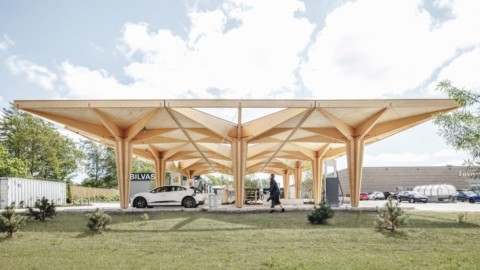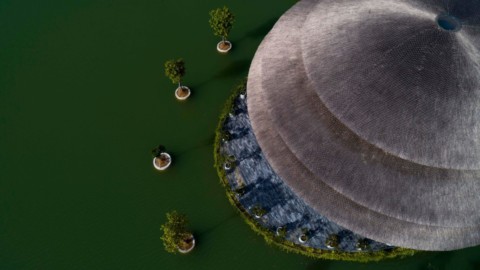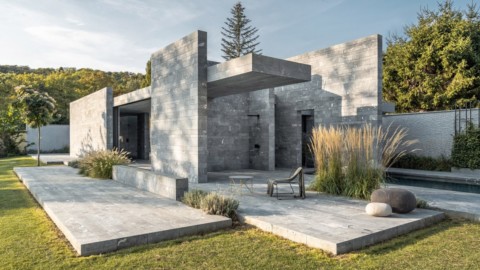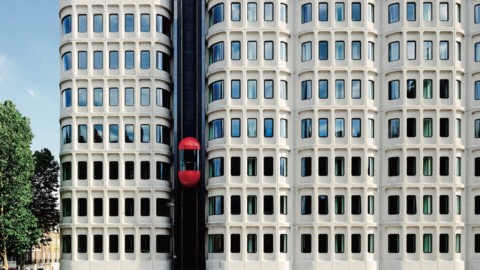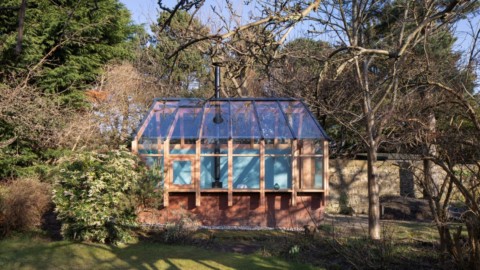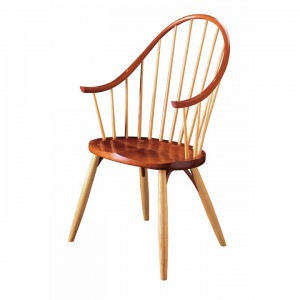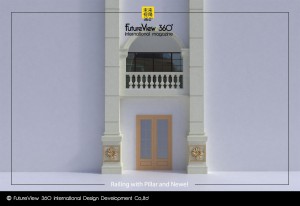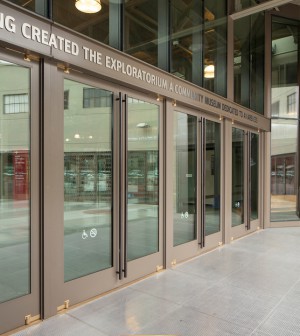Paper artist Marc Hagan-Guirey has recreated ten modernist buildings from folded and cut paper for his book Le Corbusier Paper Models: 10 Kirigami Buildings to Cut and Fold.
The book, which is released next month, contains step-by-step instructions and material to recreate 10 of Le Corbusier’s most recognisable buildings in kirigami – a variation of origami that includes cutting of the paper.
紙藝人馬克·哈根·居里(Marc Hagan-Guirey)用摺紙和剪紙為他的著作《勒·柯布西耶紙模型:剪裁和折疊的10個千紙鶴建築》重建了十座現代主義建築。
該書將於下個月發行,其中包含分步說明和材料,以重新構造勒·柯布西耶(Le Corbusier)的10個最著名的基里格米建築物-摺紙的變體,其中包括剪紙。

“Le Corbusier’s work is perfect for recreating in kirigami,” Hagan-Guirey told.
“His buildings are monolithic and punctured with an assortment of seemingly random windows shapes. These distinctive silhouettes can be perfectly rendered in the simple shapes of kirigami,” he continued.
“That’s the aim with paper architecture – to make a simple arrangement of cuts and folds into instantly recognisable historic buildings. It also helps that curved surfaces are a rarity in Le Corb’s work as they don’t translate so well to paper.”
Hagan-Guirey表示:“勒·柯布西耶(Le Corbusier)的作品非常適合重製激進摺紙。”
他繼續說:“他的建築物是整體的,並穿有各種看似隨機的窗戶形狀。這些獨特的輪廓可以用簡單的kirigami形狀完美呈現。”
“這是紙質建築的目的–將切口和摺痕簡單地排列成立即可識別的歷史建築。這也有助於使曲面在勒·科布(Le Corb)的作品中很少見,因為它們不能很好地轉化為紙張。”

The book is Hagan-Guirey’s second that focuses on architecture, following Frank Lloyd Wright Paper Models which contains 14 kirigami designs to recreate the American architect’s buildings.
This time he focused on the work of one of the pioneers of modern architecture, Swiss-French architect Le Corbusier, who Hagan-Guirey first came across while studying art in Manchester.
該書是哈根-圭瑞(Hagan-Guirey)的第二本重點研究建築的作品,緊隨弗蘭克·勞埃德·賴特(Frank Lloyd Wright)的紙模型之後,該模型包含14種摺紙設計,用於重建美國建築師的建築物。
這次,他專注於現代建築的先驅之一,瑞士-法國建築師勒·柯布西耶(Le Corbusier),他是哈根·圭裡(Hagan-Guirey)在曼徹斯特學習藝術時首次遇到的。

“I can remember coming across his work when I was writing an essay on futurism and architecture, and I discovered that aspects of Manchester’s reformation after the second world war were influenced by his thinking,” said Hagan-Guirey.
“On Oxford Road towards the university were areas with walkways above street level and the building had a section that straddled the busy traffic below – sadly that’s not there anymore,” he continued.
“I became a bit obsessed and it gave me a way for me to weave my love of science fiction into my art degree. With our cityscapes transforming at such a rapid pace, and often still based on his principles, I felt like now was a good time to put knife to paper in honour of his work.”
Hagan-Guirey說:“當我寫一篇關於未來主義和建築的論文時,我記得他的作品,我發現第二次世界大戰後曼徹斯特改革的各個方面受到他的思想的影響。”
他繼續說道:“在通往大學的牛津路上,有一些人行道在街道上,並且建築物的一部分橫跨了下面的繁忙交通,可惜現在已經不存在了。”
“我變得有點痴迷,這為我提供了一種將科幻小說的熱愛轉化為我的藝術學位的途徑。隨著我們的城市景觀以如此迅速的速度變化,並且常常仍然基於他的原理,我覺得現在就像是一個 是紀念他工作的好時機。”

The book contains some of the Swiss-French architect’s best known buildings, including the Villa Savoye in Poissy, Maison de la Culture in Firminy and the High Court in Chandigarh.
These were all among the 17 Le Corbusier-designed buildings added to UNESCO’s World Heritage List in 2016.
Alongside these buildings are the Maison Citrohan, Villa Stein-de Monzie, Maison de week-end, Maisons Jaoul, Unité d’habitation, Villa Sarabhai and Carpenter Center for the Visual Arts.
該書包含一些瑞士-法國建築師最著名的建築,包括普瓦西的薩沃伊別墅,菲米尼的文化之家和昌迪加爾的高等法院。
這些都是2016年由勒·柯布西耶(Le Corbusier)設計的17座建築之一,被聯合國教科文組織列為世界遺產。
這些建築物旁邊是Citrohan大廈,Stein-de Monzie別墅,週末大廈,Maisons Jaoul,Unitéd’habitation,Sarabhai別墅和Carpenter視覺藝術中心。
Hagan-Guirey picked the buildings that would be most suited to being recreated in paper form, while also trying to include some of the architectural highlights.
“Buildings that have many curves don’t lend themselves so well to the modular aspect of kirigami, so that was certainly an influencing factor,” he explained. “There are buildings such as Villa Savoye and Unite d’habitation that just had to go in.”
Hagan-Guirey選擇了最適合以紙質形式重建的建築物,同時還嘗試包括一些建築亮點。
他解釋說:“具有很多曲線的建築物不能很好地適應激進摺紙的模塊化方面,因此這肯定是一個影響因素。” “有些建築物如薩伏伊別墅和團結住宅就必須進入。”

Two notable omissions are the Chapelle Notre Dame du Haut at Ronchamp and the La Tourette monastery.
“Fondation Le Corbusier were very helpful and supportive but curiously they asked that no religious buildings should appear in the book,” said Hagan-Guirey.
“Notre Dame du Haut, Ronchamp is probably one of the most famous of his works, but that would have been a bit of a nightmare to do justice in paper form. Ironically that was a bit of a blessing.”
Ronchamp的Chapelle Notre Dame du Haut和La Tourette修道院是兩個值得注意的遺漏。
Hagan-Guirey說:“勒·柯布西耶基金會非常有幫助和支持,但奇怪的是,他們要求書中不要出現任何宗教建築。”
“朗尚(Notch Dame du Haut)可能是他最著名的作品之一,但是以紙面形式進行正義將是一場噩夢。具有諷刺意味的是,這真是一件幸事。”

Of all the buildings in the book it is the lesser-known Villa Sarabhai in India, which is Hagan-Guirey’s favourite.
“When you read about Le Corbusier you feel he had a bit of an ego,” he said.
“However, when you see Villa Sarabhai and learn that this ultra serious architect designed a home with a toboggan slide leading from the top of the building down into a plunge pool, you can’t help but smile at the inkling of irreverence.”
Le Corbusier was one of the best-known architects of the 20th century and one of the key proponents of modernism.
Many of his buildings are now open to visit including his former apartment within the Immeuble Molitor, which reopened to the public in 2018, and the Pavilion Le Corbusier in Zurich, which was refurbished last year.
在書中所有建築物中,最鮮為人知的是印度的Villa Sarabhai,這是Hagan-Guirey的最愛。
他說:“當你讀到關於勒·柯布西耶的書時,你會覺得他有些自負。”
“但是,當您看到Villa Sarabhai時,得知這位超認真的建築師設計了一個帶有雪橇滑道的房屋,雪橇滑道從建築物的頂部一直延伸到一個低矮的游泳池中,您會不由自主地笑著。
勒·柯布西耶(Le Corbusier)是20世紀最著名的建築師之一,也是現代主義的主要支持者之一。
他的許多建築現在都可以參觀,包括他在Immeuble Molitor內的舊公寓(於2018年重新向公眾開放)和蘇黎世的Le Corbusier亭子(於去年進行了翻新)。
https://www.dezeen.com/2020/01/15/marc-hagan-guirey-le-corbusier-paper-models-10-kirigami-buildings/


